Text

Hello! You’ve been scrolling for a while. Please take a second and rest.
Have you drank any water recently? Please do so. Hydration is important.
Have you eaten recently? Please do so. Even a small snack will help.
Did you remember to take your meds? Make sure to take them as soon as you can! They’re important to help you function.
Have you stretched recently? Rotate your shoulders back and forth. Stretch your arms above your head. Walk in a circle around your room, if you can.
Have you been in one place for a long time? See if you can switch positions or locations. Check your posture if you can.
Have you been outside today? If you’re able, open a window, or sit outside for a little bit. It’s beautiful outside right now.
Are you meant to do something else right now? That’s okay! But this is your signal to close this window and give that something a shot, if you can. Go for it. Give it your best shot.
Are you up late at night? Please sleep if you can! Your sleep schedule is important to maintain. I recommend a warm drink and heavy blankets, if you’re struggling with falling asleep, or reading a good book.
Are you tense, anxious, or upset? That’s okay! Take a deep breath. Try to name five things around you. If you’d like, you can write them in the notes of this post.
Are you panicking, disassociating, or otherwise in extreme distress? Please take several deep breaths. Remove yourself from any uncomfortable situation, if you can. Here is a list of hotlines you can call.
Are you in need of a distraction, or are you bored? Here is a website where you can create pixel art. Here is a website to color mandalas. Here is a website where you can create characters’ avatars.
Here is a website of timed poses for pose drawing. Here is a website where you can help scientists identify frog songs, transcribe letters, and identify constellations. Here is a website for sand art.
Here is the entirety of Total Drama Island. Here is the entirety of the Ever After High TV Series. Here is the entirety of A Very Potter Musical. Here is a stream of Lofi music. Here is a humor video series about animals.
You will be okay. You are loved and appreciated. I am so proud of how far you’ve come, and thank you for reading. Take care of yourself if you can, and if you struggle, I know others will help you.
If you’d like, you can keep scrolling now. Have fun!
1K notes
·
View notes
Text
remember to cry for help without guilt-tripping. i know it feels like you’ve been abandoned and betrayed, but it’s probably not true, and it’s not okay to accuse the people around you of something they might not have done.
“i guess none of you like me” could be better phrased as “i feel unloved right now”
“but nobody cares anyway” could be better phrased as “i feel insignificant and i need reassurance”
rather than assuming others’ feelings, give them time to explain them. you’ll usually get a much better answer.
190K notes
·
View notes
Text
You don’t have to be a good person.
I’m giving you permission to be selfish, to fuck up, to choose not to do what you think you should--even if you had the spoons for it that day. You don’t have to make a positive difference in the world. You can do bad things. Your intentions don't have to be pure. You don’t need to prove you’re good enough to be on this earth. You’re already here, and that’s enough reason to stay.
It takes so much pressure off when you stop trying to be “good.” And it allows you to confront the parts of yourself that you would rather change because you're not scared to acknowledge you might actually be a little bit “bad.”
#obviously I still hope you all try not to hurt other people#but if you do you still deserve to be here#what even is good/bad anyway#like who is judging you#ya know?#ocd#moral scrupulosity
84 notes
·
View notes
Photo
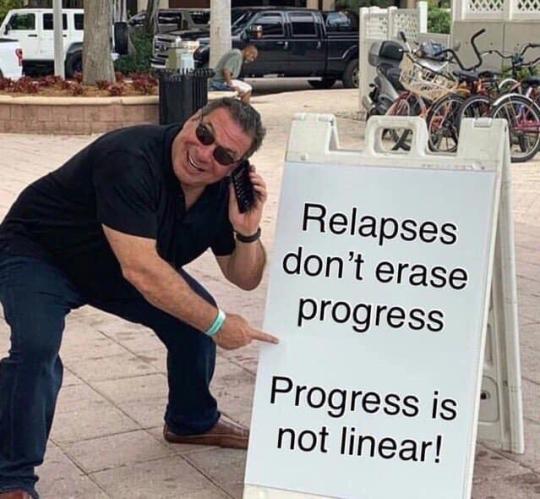
55K notes
·
View notes
Text
Distress Tolerance Skills To Use In The Moment
When should you use distress tolerance skills?
Distress tolerance skills are usually about distracting yourself from your distressing thoughts/emotions so that you don’t engage in negative behaviors. They are meant to stop your physical/mental reaction in its tracks so that you can calmly choose how to proceed. Always distracting and never confronting distressing thoughts/emotions is not a healthy way to live, so these skills aren’t meant to be an everyday fix or replace sitting with and working through your emotions. But sometimes the anxiety/rumination/emotions are all just too much, so in those instances, here are some ways you can calm yourself down:
Change your body chemistry (TIPP Skills)
Put your face in cold water (or put ice packs on your face right under your eyes) and bend over at the waist to activate your body’s dive response
Intense Exercise—run or run in place, do push-ups or jumping jacks as fast as you can for a short burst of time
Paced Breathing—try to breathe out for a longer count than you breathe in
Paired Muscle Relaxation—tense and relax each part of your body consecutively
Distract your mind (temporarily)
Do something else. Watch a movie, listen to music, play a game, talk to a friend about something random. Physically move to a different place, even another room in the house
Focus on doing something nice for someone else. Text a friend to say hi, make dinner, take your dog around the block, etc
Use physical sensations: squeeze a stress ball as hard as you can, hold an ice cube, go out in the rain, take a hot/cold shower
Ground yourself (especially if dissociated/numb)
Go through your senses and focus on what you notice about each
Look around the room--turn your head back and forth! My therapist says this helps calm you down because you can see your surroundings better and see that there isn’t a threat--name/describe 5 things that you see around you (just thinking it to yourself is ok)
Rub your fingers over something--a rock, your shirt sleeve, a plant, doesn’t matter. Or, consciously notice your feet touching the ground
Chew gum or suck on a candy and focus on the taste and feeling
Body scan: start at your toes and work your way up to your head, becoming aware of each part of your body to help ground yourself in the present/physical
Make a checklist for what to do (so you don’t have to rely on your memory when you are in distress)
Try writing out a “menu” of skills to choose from--or save this post somewhere to use as one
I have a stepped interval timer that walks me through a short routine of drinking water, taking my meds if I’ve forgotten, changing into more comfortable clothes, dimming the lights, etc, because I know that if those things are not taken care of I will feel even more overwhelmed and am less likely to deal with things productively. All I have to do is click start, instead of remembering and deciding on each individual step.
1 note
·
View note
Photo
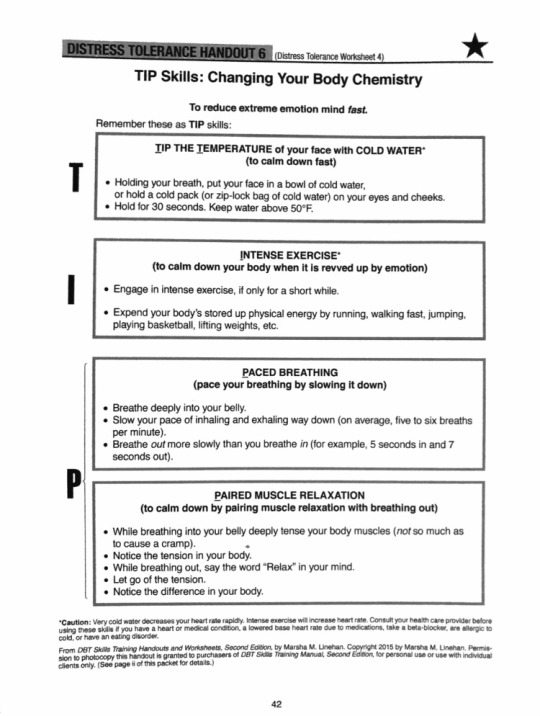

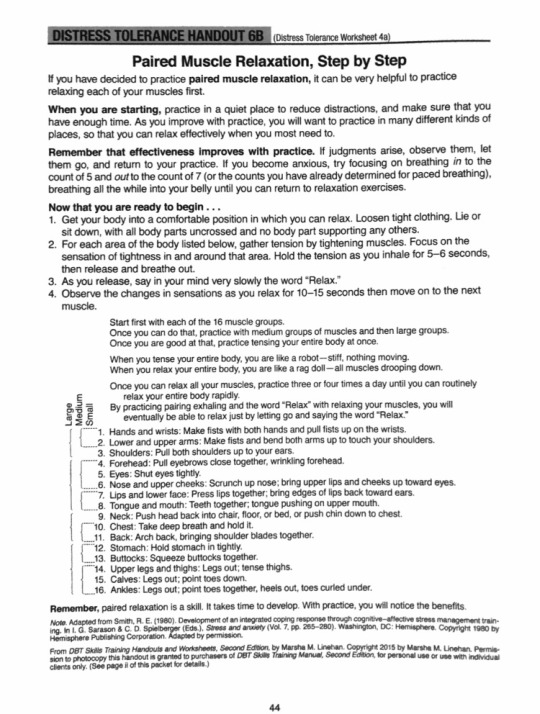
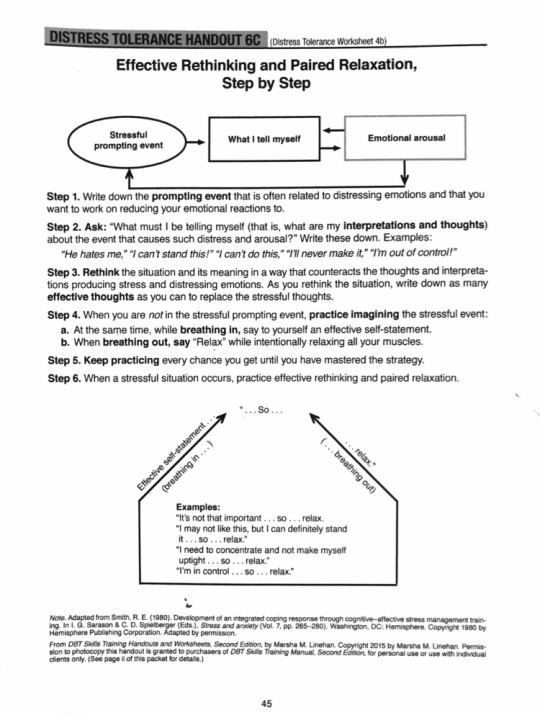
TIPP Distress Tolerance Skills from DBT
1 note
·
View note
Text
Workbooks and Self-Help Books for Mental Illnesses & Symptoms
Hello everybody! I was just thinking about how I always recommend people who can’t get therapy to use workbooks, so I thought I’d make a quick list of some you could look at. I’m not comfortable recommending books for things I have not struggled with (like, if I was looking at the description of a book on OCD I’d have no idea if it was good or not) but I think I’ve covered a lot. Some of these are series which have workbooks for specific disorders like bipolar, etc., if you want to find some. Plus, you don’t have to be diagnosed with something to use a workbook if you think it’ll help you.
Workbooks are sometimes made to be done in conjunction with therapy, or something like that, but anyone can still get something out of them if you put in regular work and try to apply the skills.
I’ve linked them all the Amazon because they’re usually cheaper on there.
For reference: DBT = dialectical behaviour therapy, CBT = cognitive behavioural therapy, ACT = acceptance and commitment therapy
Anxiety, Depression, and Intrusive Thoughts
The CBT Anxiety Solution Workbook
The Anxiety and Worry Workbook
The DBT Skills Workbook for Anxiety
The Anxiety Toolkit
Depressed and Anxious: The DBT Workbook
The Mindfulness and Acceptance Workbook for Depression
The Cognitive Behavioural Workbook for Depression
Overcoming Unwanted Intrusive Thoughts
The Anxious Thoughts Workbook
Borderline Personality Disorder
The BPD Survival Guide
Stronger Than BPD
You Untangled
Mindfulness for BPD
The BPD Toolbox
Beyond Borderline: True Stories of Recovery
Interpersonal Problems
The Interpersonal Problems Workbook
ACT for Interpersonal Issues
Anger
The DBT Skills Workbook for Anger
The Anger Workbook for Teens
Anger Management for Everyone
ACT on Life Not on Anger
Trauma and PTSD
Overcoming Trauma and PTSD
The PTSD Workbook For Teens
The Complex PTSD Workbook
You Empowered
Self Harm
Freedom from Self harm
Stopping the Pain: A Workbook for Self-Injury
Rewrite: The Journey from Self-Harm to Healing
General Emotional Issues/Multiple Disorders
Letting Go of Self-Destructive Behaviors: A Workbook
The DBT Skills Workbook
Don’t Let Emotions Run Your Life
The Mindfulness Solution for Intense Emotions
The Mindfulness-Based Emotional Balance Workbook
Thoughts and Feelings: Taking Control of Your Moods Workbook
5K notes
·
View notes
Photo

When “walking the middle path”, or finding the balance with black-and-white thinking, it’s important to distinguish potentially harmful thinking patterns. Above is a list of the common thinking patterns that DBT tries to combat.
Addressing the pattern is one of the most important steps towards recovery. It can be hard to separate disordered thinking, especially when it’s come out of a learned behaviour; sometimes seeing it on paper helps.
21K notes
·
View notes
Photo
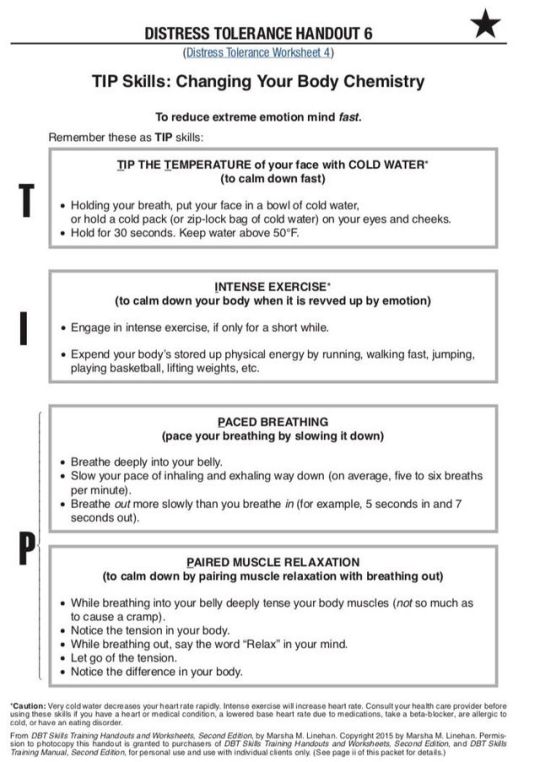


Some distress tolerance DBT worksheets. It’s important to remember to only use these when you’re at the height of emotion and you need to bring yourself down to a level where you can actually manage the problem. If you use these when you’re able to manage the problem, they’re not useful and just a distraction.
847 notes
·
View notes
Photo

Pros & Cons | Distress Tolerance
*art by Belquis Elhadi*
Pros & Cons in DBT are a little different than your average P&C. Normally, you are just evaluating the pros and cons of either doing something or not doing something, but in DBT you are evaluating them for BOTH. This functions to let you see how either can impact you.
Remember that the dialectic part of DBT tells us that nothing is black or white, there can be both good and bad in something. You will be able to find pros to doing a problem behavior, but it is in laying out the pros of NOT doing it and evaluating the effects of those pros (and cons) that lets you really get a good idea about what’s best for you.
I highly suggest writing them out and not just thinking about them. Having a physical list is helpful to see which squares have the most content and also let you rank them. When you do Pros & Cons, look at each of the answers that you gave and evaluate whether these are long term or short term pros/cons. Something may be a pro in the short term but is ultimately harmful, particularly in the long term. Remember that the goal in DBT is to create a life worth living, and to do so, you have to make choices that will impact your life positively in the long term.
EXAMPLE:
Here is a pros & cons 4 square about whether or not to self harm. (Made by Kat obviously bc the design skills are lacking sorry lol)
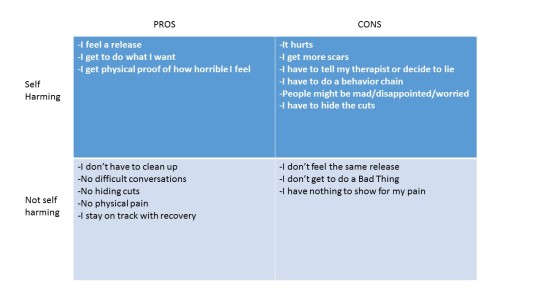
When you’re making your chart, things can get pretty confusing pretty fast because you’re dealing with double negatives. So I’d recommend before you start to make sure you have each square labelled. Then ask yourself, what are the pros of self harming? What are the cons of self harming? What are the pros of staying clean/not self harming? What are the cons of staying clean/not self harming?
It seems pretty Extra to have 4 squares instead of 2, but we all must do as Marsha says. The 4 squares show you a more comprehensive picture of the consequences of any and all actions you are considering.
AN IMPORTANT NOTE TO THE WILLFULS OUT THERE….
If you’re like me, you may make a detailed pros and cons chart, end up with more cons against doing the action than pros, and still not be convinced. I can’t tell you the number of times I’ve made this exact chart and then self harmed anyway. Not every bullet point on the chart weighs the same. Maybe feeling a release means more to you than hiding the cuts, so it’s not a balanced ledger. This is where considering the long and short term consequences and your personal goals can help.
The point of a pros and cons chart is not just to help you make a decision, it’s also to help you understand the consequences of your actions. But understanding the consequences doesn’t always prevent a “bad” decision. The power is still in your hands, just as it always will be. I’d recommend making a pros and cons 4 square for impulsive decisions when you are in wise mind, before you get the urge to make them. Then pull out the chart when you’re considering these actions and remind yourself of why you made it. In the end, it’s up to you.
~~
Our example is a common use of pros&cons, but this 4 square can be used to make any decision, whether it’s the use of a behavior or deciding whether to go out with your friends.
654 notes
·
View notes
Text
Valid vs. Justified
Something I struggled with a lot before DBT was differentiating (or even knowing there was a difference!) between an emotion being valid and an emotion being justified.
All emotions are valid: you are allowed to feel how you feel in response to things in your life. Nobody can tell you your feelings are incorrect.
Not all emotions are JUSTIFIED, or they're justified but their intensity is not. For example, someone forgets to acknowledge you and it hurts. You can validate yourself and also at the same time recognize that no, being at 90/100 on the rejected/hurt scale is not justified in this interaction. You can then decide on your response accordingly.
This is part of the dialectic. Two seemingly opposite facts can be true at the same time.
I think I've gotten better at checking my own emotional responses, but they still get the better of me sometimes, particularly guilt and shame.
Taking a second to run through this thought process has often made a huge difference for me, allowing me to respond rather than mindlessly react.
3K notes
·
View notes
Text
What is trauma response?
⚠️ TW: Mentions of abuse and the effects of trauma ⚠️
Experiencing trauma affects the way we respond to the world. It has a much deeper affect than you may think, changing the way that we process the day to day events in our lives.
What is trauma?
Trauma is anything that overwhelms your brain past your ability to cope. No matter if it seems large or small, if you are traumatized by it, it is valid. The effect of trauma ON YOU has no relation with how badly it seems someone else has it. ALL trauma is valid, and none of it can be compared.
What is trauma response?
When you experience something that reminds your brain of a trauma you experienced, you can start to escalate into a place where your logical brain is shut off. This does not have to be put together by your conscious brain. Trauma response is a visceral reaction, beyond your logical thought.
If you have been conditioned to have certain thought patterns through abuse, these thought patterns can be deeply ingrained in your response to outside stimuli.
Examples of trauma response.
(Trigger warning for description of abuse)
• Trauma: You have been taught through abuse that you are always to blame for mistakes. Your abuser withheld their love whenever something went wrong.
• New Situation: You make a small mistake in your new relationship (ex. Forgetting to turn on the dishwasher).
•Trauma Response: You immediately start panicking, worrying that your new partner will break up with you. You apologize profusely, and ask them if they’re going to leave you. Your internal dialogue may say, “You always mess everything up. You ruined this for yourself. You don’t deserve love.”
~~~~~~~~~~~~~~~~
• Trauma: Your abuser made you think you didn’t deserve to be treated well. They were cruel and unloving to you.
• New Situation: Your new friend loves you dearly. They treat you well, and tell you that you can trust them. They genuinely want to support you in your times of need.
• Trauma Response: You are unable to go to them when you need help. You don’t trust them, even though they have proven they are a good friend. You expect them to replace you with someone “better” at any moment. You lash out at them, because intimacy makes you uncomfortable.
~~~~~~~~~~~~~~~~
How to recognize trauma response, and what to do when it happens.
⚠️ Trauma response can only be worked on when you are no longer in the traumatic situation. If you are still going through abuse, trauma response is one of the ways your body keeps you safe. You must be in a place of safety BEFORE you can begin to challenge these thought patterns. ⚠️
Ask yourself:
• Am I thinking about this from a place of logic?
• Is this situation reminding me of a time I wasn’t safe? What is the reality at the present moment?
• If there is another person involved: What has this person proven to me in the past? Have they ever given me a reason to feel unsafe? (If they have, reassess if the relationship is healthy for you).
A skill to use during trauma response:
DBT STOP skill:
~~~~~~~
Stop
Take a step back
Observe the situation
Proceed effectively
~~~~~~~~
Stop what you’re doing. Take a step back, until you are able to view the situation with a logical mind. Observe what is really happening, beyond the trauma response. Proceed with this new mindset.
~~~~~~~~
It isn’t fun to realize the ways that trauma can continue to live through our bodies. However, we CAN heal from this, and create a life worth living. You are so strong. Remember that healing isn’t linear. There will be lots of steps forward, and lots backwards, but your progress matters. You can do this.
🖤 Delphine
(Follow my mental health account for more posts like this @reveriesystem )
1K notes
·
View notes
Text
Tips to stop self-harming
This is just what helped me. Maybe it can help someone else too.
First, have compassion for yourself. Self harming is a coping mechanism for dealing with emotions, thoughts, etc that are hard to experience. And although it is not a healthy coping mechanism, we do it because it works. Self harming can make things worse for us long term, but we do it because it works to relieve distressing feelings in the moment. And often, we don’t have better coping mechanisms. I used to feel incredibly guilty after self harming, which, ironically, would make me want to self harm again. You’re not “bad” for self harming. You’re doing the best with what you know in the moment. That being said, self harm is not a healthy coping mechanism, and won’t fix the underlying issues causing us to self harm.
The ultimate goal is to be able to deal with our thoughts, emotions, memories, etc. directly, without pushing them away or punishing ourselves for having them. First, though, I found it helpful to stop doing types of self harm that would leave physical injury. That meant finding substitutes for what I was doing, where I could still, essentially, self harm, but that weren’t going to leave lasting physical damage. Personally, I found holding ice cubes in my hand the best substitute, since it is really painful. Other things that I’ve heard people use for this are snapping a rubber rand on your skin, drawing on yourself with a red marker. Quick, high intensity exercise, like sprinting as fast as possible in place, can also help to release some pent-up emotions. These substitutes still aren’t necessarily healthy coping mechanisms, but they allowed me to be able to focus on confronting my underlying problems without having to worry about the physical effects of what I was doing.
In my experience, self harm is usually an attempt to avoid feeling something unpleasant. Even if we replace physically visible self-harm with ice cubes or even just other methods of avoidance like distraction, we are still avoiding dealing with the unpleasant feelings and the reason we are having them in the first place. I used to think I was strong for being able to “not feel” or react to my emotions. Now I see that I was just numbing myself, and as a result of continually pushing thoughts away, they kept coming back, stronger each time. I can’t tell you in a Tumblr post how to work through every specific situation or disorder, nor do I know how. I’m not a professional. But I can tell you that the single biggest thing that allowed me to even begin recovery in earnest was to stop trying to run from what was going on in my brain.
I started trying to just notice what was going on in my brain. Before jumping to self harm or distraction, I just tried to let myself feel and take note of what was happening in my head. I didn’t even time it or anything, just tried to push myself just past what was comfortable, and then I could engage in a method of avoidance. At first, I could only do it for a matter of seconds before I resorted to avoidance. But slowly, the amount of time that I could sit with my brain grew, and at that point, I could start really examining what was going on to make me feel so distressed in the first place and working on that. Try to notice without judgement, and if you judge yourself anyway, then notice the judgement. It’s not about forcing a particular thought pattern, but instead about acknowledging what is happening in your brain.
The last thing I’ll mention here is urge surfing. I will make a more detailed post about it and link it in the future, but the idea of urge surfing is that if you don’t act on it, the urge to self harm will peak and then gradually subside. If you act on the urge, you return to your baseline level of distress quickly: instant relief. So if you never wait it out and “surf the wave” of the urge, you never see that it does subside. Knowing this helped me get comfortable with discomfort and notice my urge to self harm without judgement.
You are so much stronger than you think! Remember the you didn’t get here overnight, so you won’t recover overnight. It will take time, but you CAN do it!
#tw self harm#recovery#recovery tips#coping mechanism#mental health#my post#depression#ocd#anxiety#self harm
11 notes
·
View notes
Text
How to talk to mental healthcare professionals and tell them what you need
Disclaimer: This is based on my own experiences in the U.S.
For years I saw various mental healthcare professionals about symptoms that were causing me trouble, and for years these professionals brushed me off and gave me waffly answers about how ‘diagnoses don’t really matter’. I’m finally diagnosed with ADHD and OCD, and I’m finally getting the help I need. If you’re also struggling to get professionals to help you, here is my advice:
1. Tell them the whole truth. If you are (mis)diagnosed with something, don’t limit yourself to explaining your experiences in terms of that diagnosis. Tell them how you really feel, and don’t leave things out. If it doesn’t fit, they can adjust the diagnosis.
2. If you bring something up as a possible explanation/diagnosis for something that is really affecting you and they tell you that you don’t have it and treat you like you are overreacting: ask them what they think could be going on instead of what you suggested. You could be wrong about the label for it, but you know you are struggling, so don’t just let the conversation end. Ask them what they think is going on, not just what is not.
3. Ask what your options are. Talk therapy and SSRIs are not the only type of treatment available. CBT and DBT focus on learning coping skills and regulating behavior. EMDR can help with trauma. ERP is what saved me from anxiety/ocd hell. There are different medication options, too, if you want to try that. The point is, there is more out there to help you than just counseling and prozac. Also, just because your therapist knows the basics of a specific type of therapy/treatment doesn’t necessarily mean they can treat you as well as a specialist, so if you have access to one, it is so worth having to start with someone new.
4. Specialists are a million times better at helping you with specific disorders, but they are not great at diagnosing you or helping with things outside of their specific focus. They tend to kind of look for their specific disorders. Not to say they don’t or can’t diagnose correctly, just that in my experience, specialists might not take into account additional factors. For instance, I was diagnosed with ocd, which was great bc I got access to treatment for it, but what the ocd specialists didn’t see was that some of my ocd behaviors were an attempt to control my undiagnosed ADHD.
5. Think of psychiatrists like specialists for meds. Because of insurance and how the system is set up, psychiatrists don’t meet with patients that often compared to therapists. Their job is really just to prescribe medication, not to spend lots of time figuring out what is going on. This kind of sucks, because often they are the ones that need to refer you for specialized treatment. You might have to do your own research to get the ball rolling in the right direction. Psychiatrists sometimes have nurses you can call that can talk to you for longer and explain medication options or take down notes about things you wanted to discuss but didn’t have time for in your appointment. In my experience, it is up to the patient to schedule appointments with their psychiatrist, otherwise months could go by without word from them. Don't feel bad about scheduling lots of appointments! It is their job to help you!!
6. If you’ve been diagnosed with depression and anxiety for ages and no one seems to be able to really tell you why you struggle with those things (especially if you’re AFAB), look into ADHD and autism. AFAB people are way under diagnosed, and it could explain why you’ve always felt ‘different’ or constantly overwhelmed. If you do feel like you fit the criteria for ADHD or autism, research and come to your appointment prepared to insist on getting evaluated. If they refuse to evaluate you, try to find someone else who will.
The bottom line here is that if you are struggling, you deserve help, and you should push for that help as much as you are able to.
Note: The mental healthcare system in the U.S. is disjointed, and unfortunately most of the responsibility falls on the patient to push for what they need. This post is not about the shortcomings of the system, but about what you can do as a patient to get the help you need in the system we have.
#how to talk to mental healthcare professionals#mental health#psychiatrists#therapy#recovery#diagnosing#accessing treatment#my post
0 notes